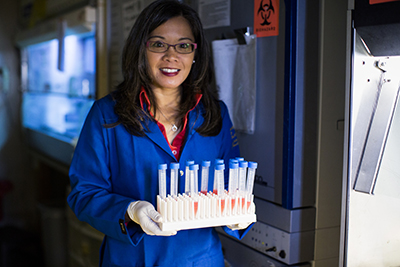
 A new study from UC Merced Professor Jennifer O. Manilay promises to shed new light on how bone diseases can affect the maintenance of healthy blood and immune cell development throughout life.
A new study from UC Merced Professor Jennifer O. Manilay promises to shed new light on how bone diseases can affect the maintenance of healthy blood and immune cell development throughout life.
Funded by a $434,000 grant over three years from the National Institutes of Health — specifically the National Heart, Lung and Blood Institute — Manilay’s study will examine how blood and bone stem cells communicate and work together, and what happens to one when the other is unhealthy.
Stem cells live in a resting state until the body sends a signal that it needs more of a specific type of blood cell. At that point, a series of “choices” are made as the stem cell divides — a new stem cell is replicated, or the stem cell differentiates to create additional cells.
The marrow in bones contain blood stem cells, and throughout life, new blood is generated, which is part of how the immune system fights diseases and infections.
“Each choice makes a different type of cell,” said Manilay, a professor with the School of Natural Sciences and Health Sciences Research Institute. “We know the processes of replicating stem cells and creating B-cells for the immune system are guided in part, at least in the early stages, by something in the bone marrow — but we don’t know what.”
Also unknown is how the aging process and bone diseases affect the production of stem cells and immune system cells. Manilay’s previous work found that when stem cells from the marrow of a healthy bone are transplanted into an unhealthy bone, a surprising thing happens — the B-cell count grows slowly or dies off, as expected, but stem cells expand in number, and continue to expand even when they are returned to a healthy bone.
The NIH-funded study will determine whether these new stem cells are born into the stable, resting state or are continuing to actively divide, which could cause other health problems. It will also go a step further, tracking the cell activity for months to see what happens to the stem cell and B-cell counts as the bone ages.
“As we age, our bones get weaker and our immune system gets weaker,” she said. “I’m wondering if there is a correlation between the two. This knowledge could lead to better stem cell therapies for blood diseases that are now treated by bone marrow and blood cell transplants, as well as a better understanding of how bone disease treatments might affect blood development.”
A Leader in STEM
In addition to her groundbreaking research, Manilay is working to help create leadership opportunities for women in science, technology, engineering and mathematics (STEM).
A founding faculty member at UC Merced and chair of the university’s Molecular and Cell Biology unit, Manilay is also an alumna of the Higher Education Resource Services (HERS) Summer Institute, a two-week program designed to help prepare women for senior leadership positions in higher education.
She was recently chosen to serve as the STEM Associate for the HERS Summer Institute at Bryn Mawr College in Pennsylvania in July. In this role, Manilay will help provide an enhanced experience for a cohort of six recipients of the Clare Boothe Luce (CBL) Scholarship, which was funded by a three-year, $450,000 grant from the Henry Luce Foundation.
Manilay will lead a special two-day orientation for the CBL participants and help them balance the goals of networking and connecting with the HERS community, while also taking appropriate time for personal reflection and planning.
“We don’t have many women in STEM in leadership positions in higher education, and we need to figure out why,” Manilay said. “I’m hoping that we’ll be able to get some solid information from HERS, and see if we can apply that information toward building strategies for women in STEM on our campus.”






